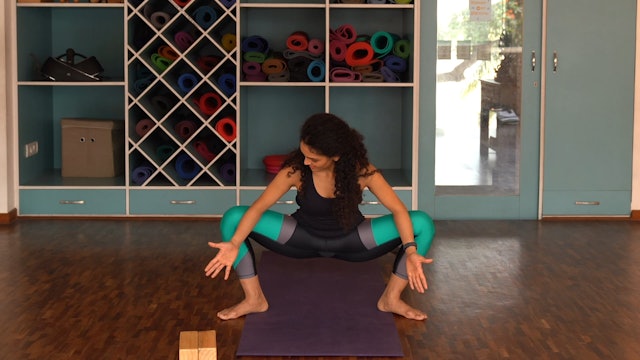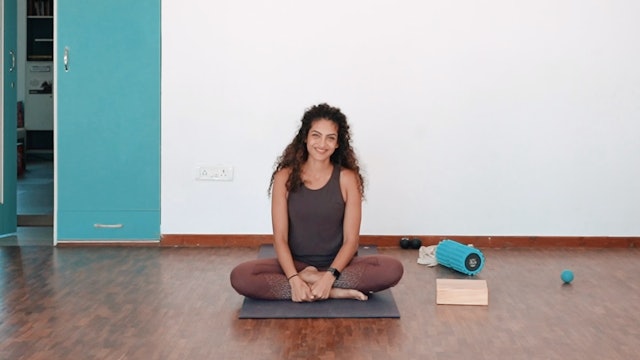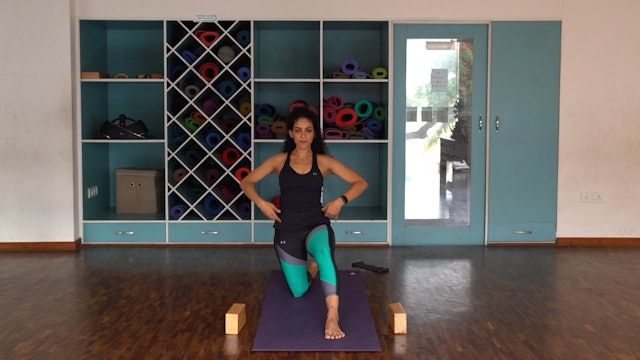Playlist 41
This playlist will concentrate specifically on Strength and Flexibility and will have a combination of both for a deep, invigorating and challenging session.
This Playlist introduces Gluteal strength and flexibility alongside a lecture on the Bhava-Vibhava & Vyabhichari Bhavas.
-
The complete Raadha Kalpa Warm Up: Level 2
This Warm- up adds a few more variations to the previously introduced warm-up and expects that your strength has progressed, so please make certain that you have practised the following though the past months, atleast 5 times each, slowly with awareness before doing this warm-up.
Legs and core 1...
-
Hip Openers
This series can be practiced after a basic warm up, before beginning an Adavu practice.
The hip opener series will help you navigate through tight hips. It will help you mobilise your hips and enable you to push your thighs back while sitting in Araimandi. Please do this in combination with str...
-
Jumping junges & Squat jumps
As your leg strength grows and develops, it is important to introduce jumps within established movement patterns so you begin to challenge your abilities. The transition from static holds to dynamic transfer must be slow and mindful.
Please do this strength regimen after a proper warm-up and on...
-
Musical Series: Core B
This sequence of exercises reinforces ideas that have already been introduced in the previous instructed series for the Core muscles/ Obliques. It is recommended to start on the musical series only once you have practised the instructed series over several months, so you already have internal awa...
-
Musical Series: Gluteals 1
This sequence of exercises reinforces ideas that have already been introduced in the previous instructed series for the Gluteals, the stability muscles in the leg/hips. It is recommended to start on the musical series only once you have practised the instructed series over several months, so you ...
-
Musical Series: Basic Quads 1
This sequence of exercises reinforces ideas that have already been introduced in the previous instructed series for the Quadriceps, the muscles in the legs that play a big part in movement. It is recommended to start on the musical series only once you have practised the instructed series over se...
-
Musical Series: Gluteals 2
Ideally practised right after the musical series 1 for the Gluteals, this sequence of exercises reinforces and develops ideas that have already been introduced in the previous instructed series for the Gluteals, the stability muscles in the leg/hips. This series also expects a certain amount of c...
-
Flexibility: Gluteals
Mobility and flexibility in the hip area is very important for a lot of movements in bharatanatyam. When there is tightness in the gluteals, it may lead to injuries in the lower back. This video helps promote mobility in the gluteals and helps open your hips and mobility in the area.
-
Flexibility: Ankles and calf muscles
Mobility and flexibility in ankles are very important for a lot of movements in bharatanatyam. When there is tightness in the ankles, it may lead to injuries in the knees and hips. This video helps promote mobility in the ankles and calf muscles and must be practised after dancing or training, no...
-
Flexibility: Shoulders & Arms
Mobility and flexibility in the arms is necessary for efficient movement to happen. When there is tightness around the arms, the movement may look restricted when dancing and you will not have proper alignment because of tightness. This video helps promote mobility in the arms and can be done alo...
-
Hamstring and Hip flexor flow
This instructional video can be used in combination with any of the other flexibility videos or after a strength section has been practised. Do not practise this before a strength workout or just before practising dance.
-
Expression Series 9: Vibhāva, Anubhāva, Vyabhichāri bhāva
This lecture explains the relationship between Vibhāva, Anubhāva and Vyabhichāri bhāva. It cites examples from life and helps the student understand how emotion is created in a performance.













